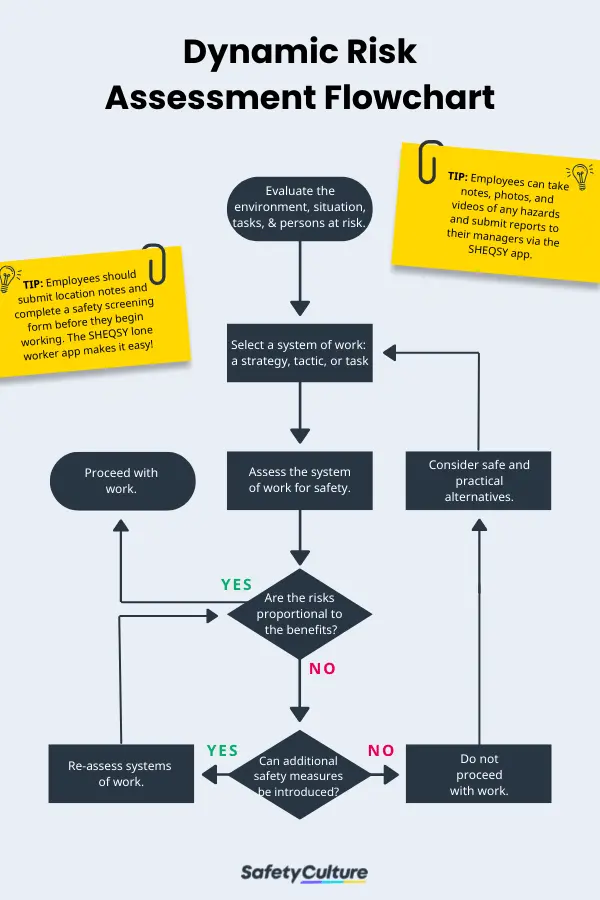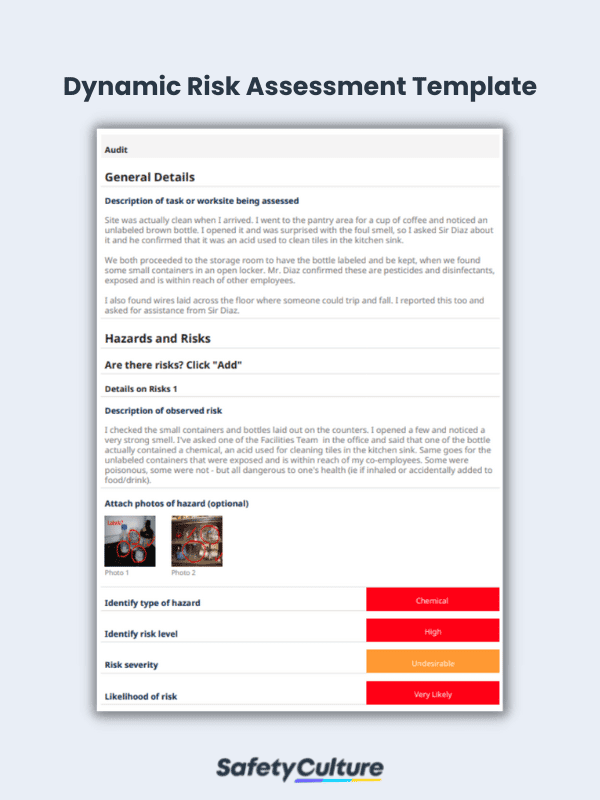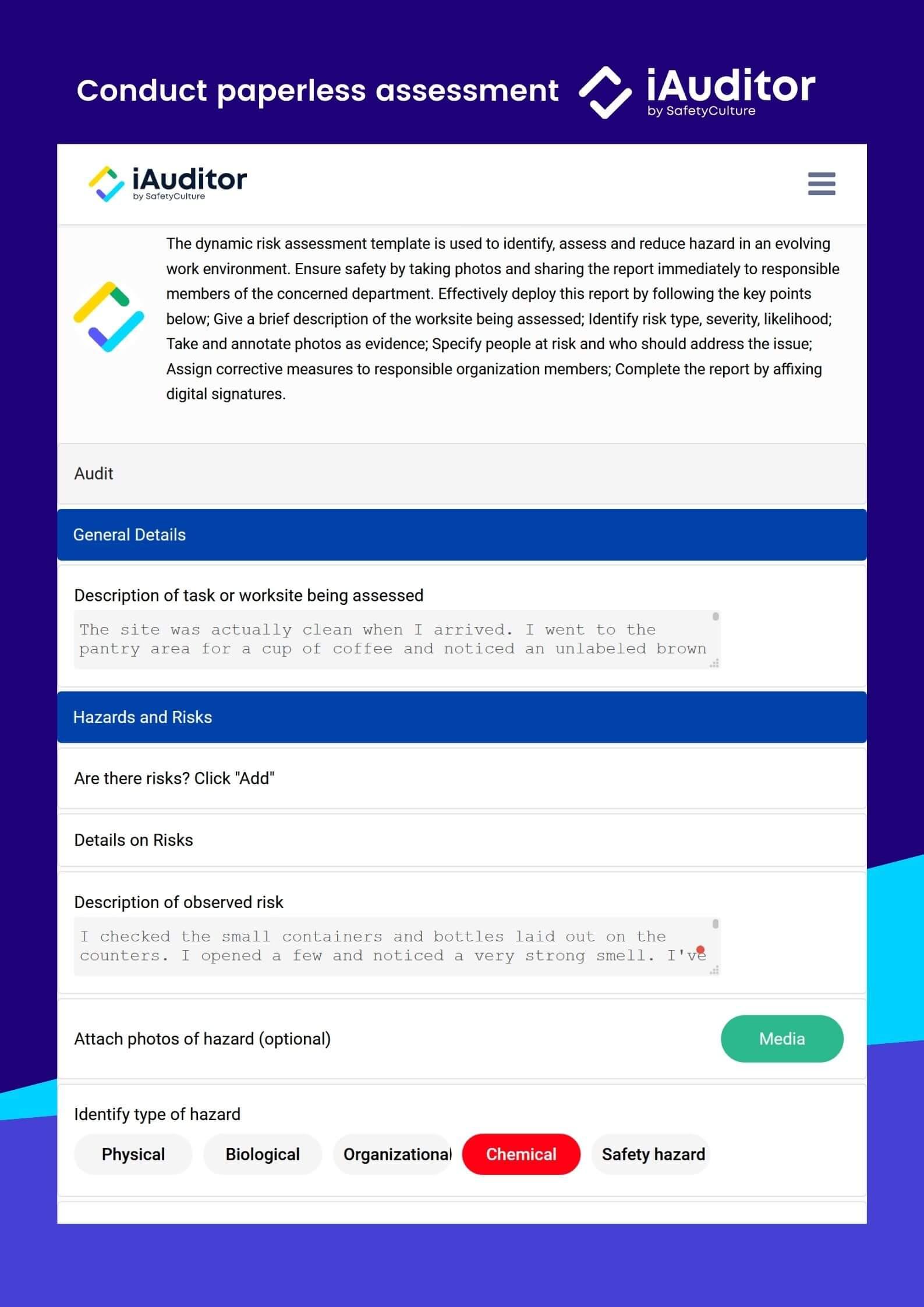What is Dynamic Risk Assessment?
A dynamic risk assessment is a process of quickly identifying risks and hazards in a workplace where the situation is dynamic and risks can change due to rapidly changing conditions. It is conducted by competent persons in charge to implement control measures and mitigate dynamic risks.
Why Perform Dynamic Risk Assessments
Dynamic risks are those that are difficult to predict and can result from organizational and environmental changes, e.g., slip hazards caused by bad weather or physical danger from visiting someone’s home. While conducting a dynamic risk assessment is not a legal requirement, HSE recommends it as it promotes safety. Manual handling and lone workers pose a higher dynamic risk due to the nature of their work. Performing dynamic risk assessments can help businesses identify, connect, and visualize critical risk clusters present in the workplace. This can help reduce the risk of workplace accidents and injuries caused by difficult-to-predict hazards.
Workers that conduct dynamic risk assessments can experience other benefits such as:
- Increase in risk awareness
- Decrease in the likelihood of incidents
- Learn quick thinking
- Being better at reading situations and making decisions
- Applying the correct actions
When is a Dynamic Risk Assessment Used?
Regular observations and assessments of your environment are necessary to predict unforeseen events. A dynamic risk assessment helps when risks and hazards arise from the following circumstances:
- Introduction of new equipment/resources
- Change of supervision approach
- Opening a new line of business
- Reallocation of work
- When there are threats to safety and security
What is the Difference Between a Risk Assessment and a Dynamic Risk Assessment?
A risk assessment is conducted when there’s a new process or new equipment in the workplace in order to determine risks and proactively come up with safety measures before the implementation of the new process or use of the new equipment. A dynamic risk assessment on the other hand is more spontaneous especially in high-risk environments where it is conducted on the spot when there’s a sudden change in the situation and risks need to be immediately identified and controlled.
How do you Conduct a Dynamic Risk Assessment?
A dynamic risk assessment is conducted with the help of a dynamic risk assessment flowchart for high-risk jobs where situations and risks can drastically change. One of these high-risk jobs is that of being a firefighter and the UK Fire Service Resources (UKFRS) acknowledges these risks and thus provides resources and methods in the form of a flowchart that contains the thought process applicable in risky situations.

Dynamic Risk Assessment Flowchart | SafetyCulture
The dynamic risk assessment flowchart has been a reliable process for hazardous work.
The 5 steps to Performing a Dynamic Risk Assessment
Another method is to apply and remember these 5 steps to performing a dynamic risk assessment. These steps are similar to the earlier flowchart but explained more thoroughly. Here are the 5 steps to performing a dynamic risk assessment:
- Stop and look around – before starting work, make it a habit to observe the environment for any hazards present such as physical, biological, organizational, chemical or safety hazard. Identify and rate the risk level, severity and likelihood.
- Check and select – check for available safety systems of work and select the most appropriate for the situation.
- Examine – assess the chosen systems of work. Once a course of action has been determined as offensive or defensive, you need to decide whether or not the risks involved are aligned with the benefits of the outcome.If YES, proceed with allocating responsibilities and communicating safety measures and procedures.If NO, go back to step 2.
- Add more measures as needed – introducing additional control measures can help further reduce or eliminate risks to an acceptable level. (e.g. use of additional PPE and specialised equipment)
- Document and report all findings – all findings should be properly documented for review and safety planning purposes.
Dynamic Risk Assessment Example
Below is an excerpt from a dynamic risk assessment example as automatically generated by the SafetyCulture (formerly iAuditor) dynamic risk assessment template (click here to view the complete sample report):
| Description of task or worksite being assessed | Site was actually clean when I arrived. I went to the pantry area for a cup of coffee and noticed an unlabeled brown bottle. I opened it and was surprised with the foul smell, so I asked Sir Diaz about it and he confirmed that it was an acid used to clean tiles in the kitchen sink. We both proceeded to the storage room to have the bottle labeled and be kept, when we found some small containers in an open locker. Mr. Diaz confirmed these are pesticides and disinfectants, exposed and is within reach of other employees. |
| Description of observed risk | I checked the small containers and bottles laid out on the counters. I opened a few and noticed a very strong smell. I’ve asked one of the Facilities Team in the office and said that one of the bottles actually contained a chemical, an acid used for cleaning tiles in the kitchen sink. Same goes for the unlabeled containers that were exposed and are within reach of my co-employees. Some were poisonous, some were not – but all dangerous to one’s health (e.g. if inhaled or accidentally added to food/drink). |
| Type of Hazard | Chemical |
| Risk Likelihood | Very Likely |
| Risk Severity | Undesirable |
| Risk Level | Very Likely |
| Persons at Risk | All employees (including me) using the kitchen area. Facilities Team could be in danger too as they utilize the Storage Room for supplies and other kept machines. |
| Department(s) involved in implementing safety | Facilities Department, Risk and Safety Team |
| What needs to be done? | Chemicals in bottles and containers, whatever the size, should be properly labeled and must be kept in a cabinet with a proper lock to avoid confusion or accidental usage. |
| Additional comments and recommendations | I assigned an Action to Mr. Diaz about this and offered my help too. We should resolve this ASAP on Monday morning when all of the Facilities Team would be present. |




